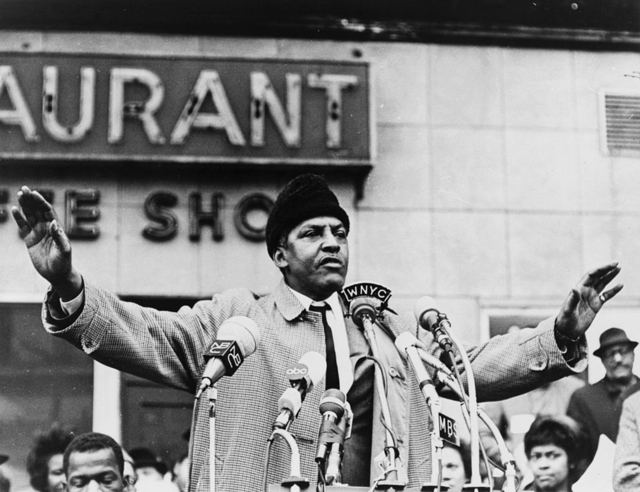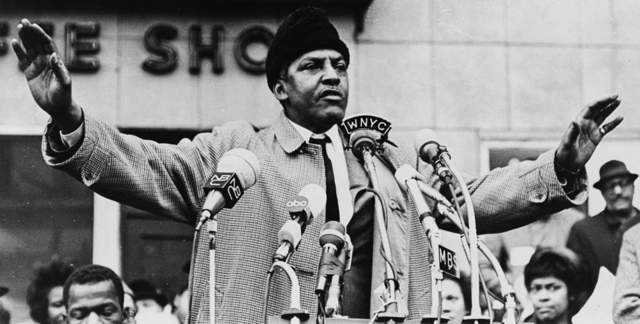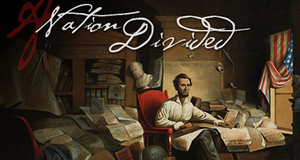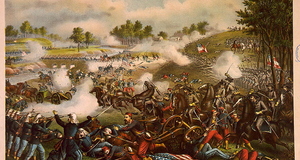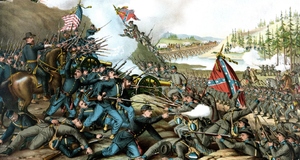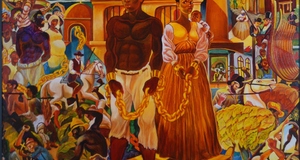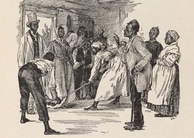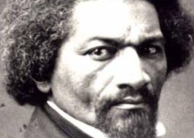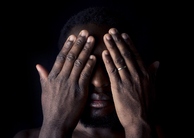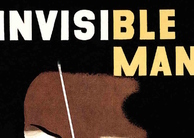Featured Article:The "Roving Ambassador:" Bayard Rustin's Quaker Cosmopolitanism and the Civil Rights Movement
By
2014, Vol. 6 No. 04 | pg. 1/4 | »
IN THIS ARTICLE
KEYWORDS
"As you know," wrote Bayard Rustin to Charles S. Johnson, the president of Fisk University, in December 1946, "I have been interested for some years in the nonviolent revolution which Gandhi and Nehru have been leading in India." Just eight months after Gandhi's assassination, Rustin arrived in India to give a series of lectures to pacifist organizations. Between 1947 and 1952, Rustin made several important trips to Africa and India where he met and exchanged ideas with other prominent social reformers, which left an indelible imprint on his strategies of organizing African-American protest. While these highly successful lectures gained valuable political traction for the African-American cause, A. J. Muste feared Rustin was overly invested in global pacifist movements. As director of the Fellowship of Reconciliation (FOR), Muste chided Rustin as a "roving ambassador," underscoring a strain of disapproval for the latter's increasing participation in international affairs. Muste firmly asserted that Rustin's political acumen and brilliant organizational talent belonged - first and foremost - in the United States. Rustin, on the other hand, felt torn between the African-American civil rights movement and political conundrums abroad, believing that an emerging international dialogue between grassroots and global protest offered valuable contributions to the politics of the civil rights movement at home.
"My activism," wrote Rustin near the end of his life, "did not spring from being black. Rather, it is rooted fundamentally in my Quaker upbringing and the values instilled in me by the grandparents who reared me... Those values were based on the concept of a single human family and the belief that all members of that family are equal." As an African-American Quaker, Rustin exhorted leaders and activists alike to practice nonviolent and peaceful protest. Indeed, Rustin advised Dr. Martin Luther King Jr. to jettison his arms in order to fully embrace a nonviolent movement. Quaker values, especially pacifism, shaped Rustin's political sentiments and, ultimately, the course of action African-American activists took when mounting political protest. To understand the impact of Rustin's pacifism on the civil rights movement, this essay explores Rustin's early life, his experiences abroad, and the impact of those experiences on his wok at home in the United States. First, Rustin's early activism -- particularly his participation in the Fellowship of Reconciliation (FOR) -- is considered. Second, the essay interrogates how Rustin's experiences abroad played a critical role in synthesizing Quaker and Gandhian philosophy. Finally, this essay questions the extent to which Rustin's involvement in international pacifist programs shaped the global reception of Quaker principles.Quaker BeginningsTo develop an understanding of Rustin's international political travels, it is useful to contextualize his experiences abroad by considering how his Quaker upbringing influenced his political activism. On March 17, 1912, Rustin was born into a Quaker community that had maintained a strong religious presence in southeastern Pennsylvania since its founding in 1799. Established by affluent Quaker farmers and merchants, the town of West Chester expanded into a lively center of agriculture, business and trade. Isolated but prosperous, West Chester remained a self-sufficient town until it was slowly absorbed into the suburbs of residential Philadelphia at the end of the nineteenth-century. The community of colonial West Chester was predominantly comprised of Quakers, but consisted of small pockets of Catholics and Protestants. The considerable presence of African-Americans was due, in part, to the community's role in operating a surreptitious rescue service for fugitive slaves who had escaped over the Mason-Dixon line. Historian Jervis Anderson charts the community's role in providing "hospitable" refuge for runaway slaves: "Many of the escapees were rescued and sheltered temporarily by those Quakers -- who, honoring the ethics of their religion, had an abhorrence of chattel slavery" (Anderson 21). In this way, the Quakers' solicitude for escapees confirms that the town's African-American community was largely the descendant of fugitive slaves. Curiously, notes Jervis, "there was a strange, or perhaps not so strange, contradiction in the social morality of early American Quakers -- more formally, the Religious Society of Friends" (21). While Quakers emphatically denounced the institution of slavery, preached human unity and worked tirelessly to evangelize Native Americans and African-Americans, they refused to integrate worship (21). Additionally, Quaker meetings were predominantly white gatherings; however, when African-Americans did attend, they were ordered to occupy segregated seating. Anderson states: Thus the humane tradition of Quaker faith did not long survive among most of the African-Americans who had been introduced to it. In other Protestant bodies throughout America, where free blacks had been similarly treated, they had eventually left and formed congregations of their own. (22) For converts and onlookers, this tacit strain of racism prompted non-white members to view the Quakers as hopeless stalwarts of racial segregation. Surely, it appeared as if the Quaker mission of caring for fugitive slaves ceased abruptly after their conversion, not providing the nurturing resources necessary for ensuring the spiritual growth of those individuals. Despite the simmering strains of racism that undergirded the customs of West Chester, the Religious Society of Friends continued to serve as a vital coordinate on the Underground Railroad. Against this backdrop of religious tradition and tacit racism, Rustin was reared by his grandparents, Julia Davis and Janifer Rustin. Married in 1891, Julia met Janifer in West Chester during a period following abolition when an influx of African-Americans migrated to the North, fleeing the cruel Jim Crow laws and rife unemployment of the South. The disparate religious backgrounds of Rustin's grandparents, however, was the source of much contention. Having attended Quaker meetings and services all her life, Julia was troubled by her husband's membership in the African Methodist Church (AME). Founded in 1816, the AME emerged as an independent church following an acrimonious dispute over segregated seating enforced by white Methodists. As Anderson points out in Rustin's biography, the AME church sharply contrasted from Quaker traditions: "One of Julia's more difficult adjustments must surely have been to AME liturgy: the music, the singing, the authoritative sermonizing, alien to the tradition of Quaker worship" (23). To be sure, Julia's Quaker customs clashed with the outspoken and zealous AME church, but she joined the former in an effort to relieve the marital tension. 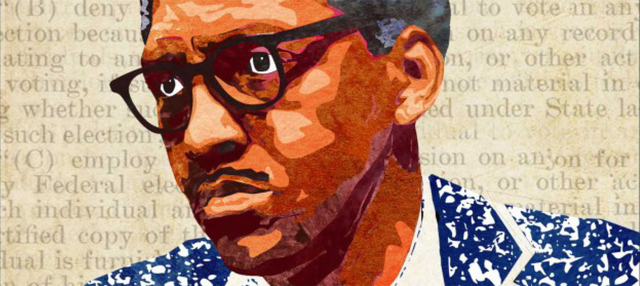
Image from Bayard Rustin: Who is this man? (STATEOFTHEREUNION.COM) Of critical importance in Rustin's early development was his double exposure to the teachings of the Quaker and AME churches. Despite her membership in the AME denomination, Julia insisted on instructing young Bayard in the Quaker faith. Recalling decades later, Rustin expressed a deep appreciation for his grandmother's melding of Quaker morality, homespun wisdom and shrewd wit: "I was taught that it was too tiresome to hate [. . . and the simple idea] that no one was unimportant [that it was] our duty to treat each person as a complete human being" (24). Additionally, grandmother Julia participated in West Chester politics by serving as a charter member of the NAACP and often providing housing for W. E. B. Du Bois and James Weldon Johnston when they arrived in town on business. Rustin's childhood, however, was not steeped exclusively in Quaker traditions: the AME faith figured prominently in his upbringing as he attended the Gay Street elementary school. One of Rustin's classmates underscores the strong influence the AME had on Rustin's spiritual formation: "The Gay Street school faculty and the AME church played an important part in [Rustin's] early development. Though segregated, the school [. . .] addressed many of the urgent topics of the day having to do with the advancement of race relations" (25). The AME church, then, recognized the vital importance of consciousness-raising in promoting political sensitivity among black youth. Here, it is important to note that Rustin was situated between two very different Christian traditions. While the historic pacifist Quaker church preached racial equality, it maintained the humiliating customs of segregation, and the AME church ordained African-Americans and sermonized a militant message of black leadership and the injustices of racial oppression. For the duration of his political career, Rustin merged both traditions in a creative way that would achieve social reform. Rustin's Quaker grandmother was also his loving confidant when it came to matters of his homosexuality. Rustin later explained that he knew his sexuality at a very young age and recalls understanding his grandmother's tolerance not as an "encouragement," but as a "recognition" (155). When Rustin was a graduating senior at West Chester High School in 1932, he demonstrated a rare aptitude for social protest. The first episode occurred at the movie theatre, the Warner and the Rialto, where rather than beginning the degrading ascent to what was then dubbed "Nigger Heaven," or the theatre's segregated balcony, Rustin decided to sit in the Whites-only section. Refusing to leave his seat, Rustin was quietly arrested and released shortly after. The second episode occurred while Rustin was a player on the West Chester Warriors football team. Routinely voicing his disgust for the school's segregated locker-room, Rustin urged his African-American teammates to protest this Jim Crow practice. A day before a major tournament, Rustin and his teammates gave his coach an ultimatum: either he desegregate the team's locker-room or they would refuse to play. To the surprise of Rustin's friends, the coach capitulated and merged the team's quarters. Thus, Rustin demonstrated a nascent talent for organizing social activism that, interestingly, reflected the converging influences of both Quaker and AME religious principles. Although it was too soon to determine the full extent of this influence, both churches presented young Bayard with a broad range of possibilities for expressing a politically active Christian life and what resistance could accomplish; that is, while Quaker worship afforded critical reflection, his grandfather's AME church demonstrated the zeal and militancy that animated Rustin's expressions of Quaker pacifism. The salient differences of these denominations empowered Rustin to formulate a cross-denominational approach to social reform. Reflecting on Rustin's brazen ambition for instigating social change, his classmate, Charles Porter, commented: "In those days, people called you something worse than radical for taking the stands Bayard did. They called you crazy. In fact, those of us following Bayard did wonder at times whether he was a bit crazy" (28). Crazy or radical, these small efforts to desegregate his provincial Quaker hometown prepared Rustin for the larger projects he would shoulder during the civil rights movement.Continued on Next Page » Suggested Reading from Inquiries Journal
Inquiries Journal provides undergraduate and graduate students around the world a platform for the wide dissemination of academic work over a range of core disciplines. Representing the work of students from hundreds of institutions around the globe, Inquiries Journal's large database of academic articles is completely free. Learn more | Blog | Submit Latest in African-American Studies |

